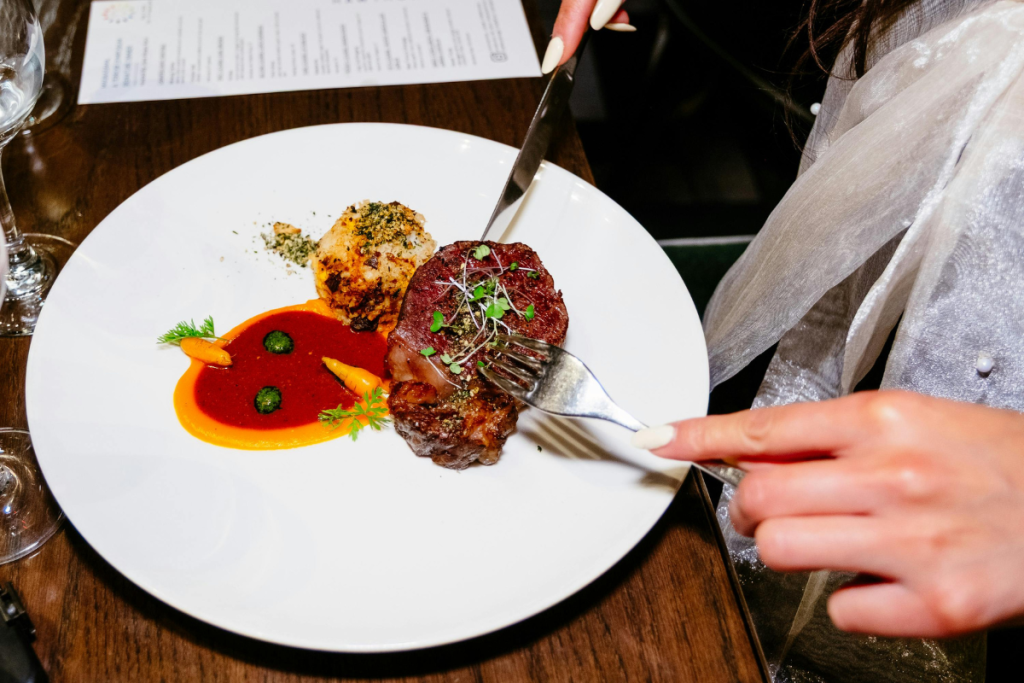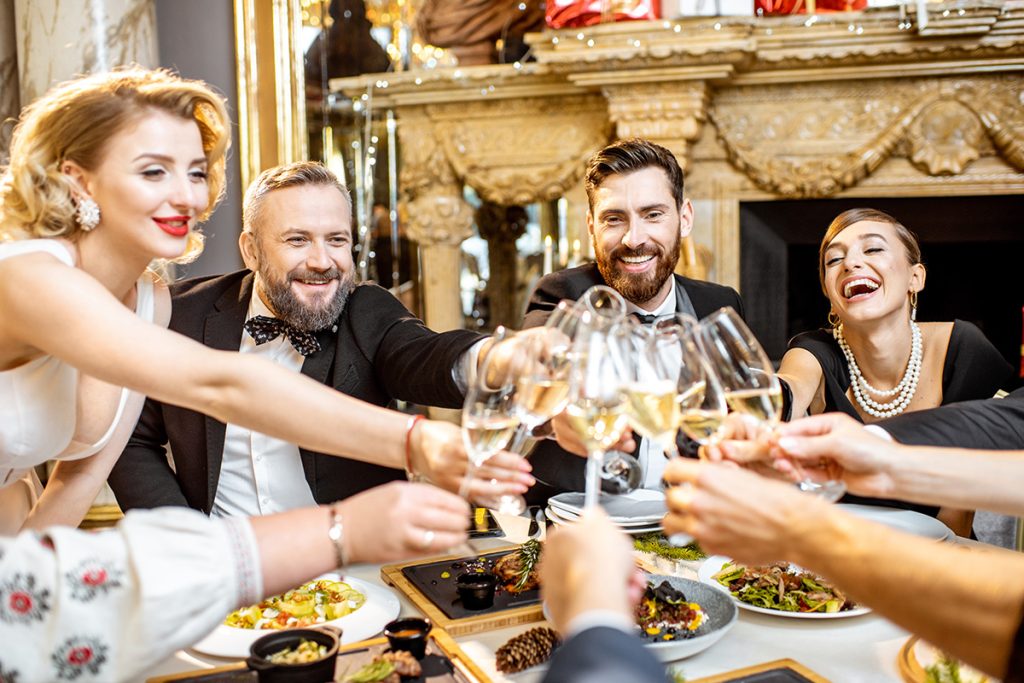When it comes to eating out, there’s a big difference between fine dining vs casual dining, but both are about more than just food, they’re about connection. Whether it’s a laid-back lunch with friends or an intimate, upscale dinner, dining brings people together. It’s a time for sharing stories, laughter, and enjoying each other’s company.
Food is often a way to celebrate milestones, treat ourselves, or show love to others. The type of restaurant, menu choices, and overall vibe all reflect the importance of the moment. At the end of the day, eating together is one of the simplest yet most meaningful expressions of human connection. So, let’s dive into what makes fine dining and casual dining so different!
Fine Dining vs Casual Dining

What is Fine Dining?
Fine dining means a high-end culinary experience. Fine dining is all about quality, premium food, exceptional service, and an upscale atmosphere. It’s a special experience where every detail counts, from the food presentation to the wine pairings. Think of it as more than just a meal, it’s a celebration, a way to treat yourself, or mark a special occasion like an anniversary or business dinner. It’s all about enjoying the finer things in life.
A fine dining restaurant offers a sophisticated vibe where dining becomes an art form, and every moment feels exclusive. Places like Seven Paintings Ubud offer an unforgettable dining experience that’s all about appreciating the details and savoring the moment.
What is Casual Dining?
Casual dining means a relaxed dining experience. Casual dining is all about a laid-back atmosphere where you can enjoy a great meal without any formality. The menu offers a variety of affordable to mid-range options, with friendly service that makes you feel right at home. Whether you’re dining with friends, family, or enjoying a solo meal, casual dining is perfect for everyday meals, socializing, or grabbing lunch during your workday.
It’s the ideal spot for a relaxed yet enjoyable experience. Restaurants like Habitat Bistro and Norii Japanese Restaurant are great examples of casual dining, offering delicious food in a comfy, welcoming setting suitable for all ages.
What is the Difference Between Casual Dining and Fine Dining?

1. Ambiance
- Fine Dining
A fine dining restaurant offers an exclusive, calm atmosphere with attention to every little detail. The decor is elegant, with warm lighting, soft instrumental music, and a setting that encourages intimate conversations and a sophisticated dining experience. Fine dining spots are typically located in premium areas, luxury hotels, or iconic buildings.
- Casual Dining
In contrast, a casual dining restaurant has a much more relaxed and welcoming vibe. The music is usually upbeat, the lighting is bright, and the atmosphere is great for laughter, casual chats, or bringing the kids along. Many casual dining restaurants even have specific themes that connect with modern lifestyles, making it easy to enjoy a laid-back meal.
2. Price
- Fine Dining
At a fine dining restaurant, you’ll find higher prices due to premium ingredients, artistic plating, and highly personalized service. The menu is often multi-course (starter, main course, dessert) and may include wine pairings. The price reflects the full dining experience, not just the food.
- Casual Dining
On the other hand, casual dining is much more affordable and flexible. You can order à la carte without the pressure of following a formal menu structure. It’s ideal for a quick lunch with coworkers, a family dinner, or a relaxed meet-up with friends.
3. Menu
- Fine Dining
A fine dining restaurant offers a menu that’s carefully crafted by professional chefs. The dishes are prepared using advanced cooking techniques with high-quality ingredients, often inspired by seasonal themes or specific philosophies. The plating is like a work of art, and each dish is usually explained by the waiter to enhance your immersive dinner experience.
- Casual Dining
In contrast, casual dining offers a more familiar menu, making it accessible to a wider range of people. You’ll find burgers, pasta, pizza, salads, and steaks on the menu. The food is still tasty and high quality, but without the formality and artistic flair that comes with fine dining. It’s a more laid-back new dining experience.
4. Convenience
- Fine Dining
Fine dining often requires reservations, especially on weekends or during peak seasons. The dining experience is more leisurely, with each course served at a comfortable pace, allowing guests to enjoy every detail.
- Casual Dining
Casual dining is much more flexible. You can walk in without a reservation, choose to sit inside or outside, and adjust your dining time. This makes it a great option for spontaneous meals, families, or a quick but comfortable lunch.
5. Dress Code
- Fine Dining
Fine dining typically calls for formal or smart-casual attire. Some restaurants may have rules against sandals or overly casual clothes to maintain an elegant atmosphere.
- Casual Dining
On the other hand, casual dining has a relaxed dress code. You can wear jeans, t-shirts, or even beachwear as long as it’s appropriate for the setting. This makes it more relaxed and welcoming for a variety of occasions.
6. Service
- Fine Dining
In fine dining, the service is top-notch and very formal. Waitstaff are highly trained in etiquette, wine pairing, and explaining the menu. Each table usually has its own waiter who ensures everything runs smoothly without interrupting the experience. The service is personalized, focused on details, and designed to make your dining experience feel special.
- Casual Dining
On the other hand, casual dining offers friendly, quick service with a relaxed vibe. Waitstaff still provide excellent service but without the formality of fine dining. They may serve multiple tables at once, and guests usually place orders without needing detailed menu explanations. The focus is on efficiency and comfort, keeping things laid-back and easy.
7. Table Settings
- Fine Dining
In fine dining, the table setting follows international etiquette. You’ll find multiple utensils, wine and water glasses, and a charger plate for each course. The attention to detail is high, with linen napkins, decorative tablecloths, and often floral arrangements to create a luxurious ambiance.
- Casual Dining
In casual dining, the table setting is simpler and practical. You’ll usually get one set of cutlery, paper napkins, and fewer glasses. The setup is designed for quick turnover and easy cleanup, keeping the experience relaxed and efficient.
8. Size
- Fine Dining
Fine dining spots tend to have fewer tables to maintain a more exclusive and intimate atmosphere. With space between tables, it feels more private and special. Some fine dining places even have just 10-20 tables to keep things intimate and focused on the experience.
- Casual Dining
Casual dining places are usually larger with a more efficient seating layout. Tables are placed closer together to accommodate more guests at once. This is designed to handle high turnover, making it perfect for families, groups, or casual drop-ins.
9. Beverages
- Fine Dining:
In fine dining, the drink selection is high-end and carefully chosen. You’ll find an exclusive wine list featuring champagne, local and imported wines, as well as premium spirits like single malt whiskey, aged rum, and signature cocktails. Many fine dining restaurants also have sommeliers to help you pick the perfect wine to go with your meal. Even the mineral water selection includes sparkling and still options from international brands.
- Casual Dining:
At casual dining spots, the drink options are simpler and more practical. You’ll usually find soft drinks, mocktails, coffee, tea, and local beers. While some places might offer wine or cocktails, the selection isn’t as extensive or exclusive as in fine dining. It’s all about comfort and practicality, without the complex pairing or extensive drink lists.
10. Reservations
- Fine Dining:
Reservations are almost always needed at fine dining restaurants, especially during busy times like weekends. Many places only take guests who’ve booked ahead to ensure they can provide top-notch service. Some fine dining spots even offer private dining experiences that require reservations well in advance.
- Casual Dining:
For casual dining, reservations aren’t usually necessary. Most guests walk in, especially on weekdays. However, it’s a good idea to reserve a table if you’re coming with a large group or visiting on a busy weekend. The process is more relaxed, and the restaurants tend to manage table turnover quickly.
FAQs about fine dining vs. casual dining
1. Why are fine dining portions so small?
Fine dining portions are small because the focus is on quality, flavor, and presentation. Each dish is part of a sequence of courses meant to complement each other, rather than just fill you up.
2. How to dress for casual fine dining?
For casual fine dining, go for smart casual. A neat shirt or blouse, pants or a skirt, and closed-toe shoes work well. Avoid overly casual items like sandals or T-shirts.
3. What is the casual dining dress code?
Casual dining doesn’t have strict dress codes. Feel free to wear T-shirts, jeans, and sneakers, as long as they’re clean and neat.
4. What are the three major types of dining options?
- Fine Dining: Luxury spots with formal service and high-quality food, perfect for special occasions.
- Casual Dining: Relaxed places with diverse menus and table service, ideal for family meals or gatherings with friends.
- Fast Food/Quick Service: Affordable and quick meals, with fast service and easy ordering, perfect for when you’re in a rush.
Final Thought on Fine Dining and Casual Dining

Whether you’re seeking an upscale celebration or a laid-back meal with friends, fine dining vs casual dining offers distinct experiences that cater to different tastes and occasions.
Fine dining is all about luxury, quality, and attention to detail, making it perfect for special events. On the other hand, casual dining is relaxed, comfortable, and ideal for everyday meals or casual socializing.
No matter the occasion, both fine dining and casual styles provide unforgettable dining experiences.
For those seeking an exceptional dining experience in Ubud, be sure to check out Seven Paintings Ubud for an unforgettable meal. Visit Seven Paintings Ubud’s website to book your next dining experience today!
